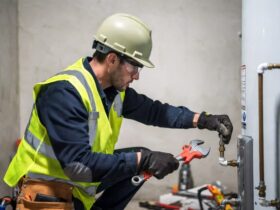No products in the cart.
How to Create a Paint Booth in Your Warehouse

Paint booths are used for paint applications designed to contain toxic or hazardous vapors and fumes. These booths are highly controlled environments to provide a safe and healthy work area for painters. Safety practitioners have created some requirements for the paint booth to assure that the person inside is well ventilated and safe.
Comply with OSHA Air Quality Requirements
As mentioned, a paint booth is an enclosed room to cater to painting services that are free from other foreign objects or contaminants from the environment. There are two types of filters recommended by Occupational Safety and Health Specialists, one is the installation of an exhaust fan to trap spray fumes before it is released to the environment. Another filter is known as the intake filter that filters out dust, dirt, insects, or other foreign materials before they can enter the paint booth.
Use a Downdraft Spray Booth
A downdraft spray booth system allows clean air to pass from the ceiling and exhausts to the floor. This will allow clean air to enter the booth, making it safe for the person inside the painting booth. It also provides clean air quality to make a flawless surface that is free from dust or any debris.
Operate at Negative Pressure
Use negative pressure to prevent mist from the paint booth from entering the general workplace. Air pressure in the booth should be a little lower than the outside pressure to carefully draw air into the paint booth.
Install a Velometer to Measure Face Velocity
Maintain good airflow in the paint booth to avoid any overspray from the spray gun. Measure the booth’s ventilation with a velometer, together with a thermal anemometer. Measuring this will allow you to check air movement and ensure that proper airflow is emitted at the operator’s breathing zone.
Paint Booth Walls
There are two types of walls used in paint booths. One is a Single skin panel. This type has a strong and excellent quality. This type of wall is easy to clean. Another type is a dual-skin panel that gives a stronger and long-lasting paint booth. These are the noise-reducing type of walls due to their additional insulation which also maintains heated air outside the booth. Walls are typically white-coated to reflect light and make it easy for the painter to see what he is painting.
Intake Plenum
Air is introduced through the intake plenum located at the top of the pressurized paint booth. Install filters in the intake plenum to ensure that dirt and dust are captured before the air enters the spray booth. The air that enters the booth through the intake plenum will flow in parallel or down from an overhead plenum.
Install Manometers
Manometers are used to measure differential pressure. Once this measure goes beyond the specified design limit to maintain clean air, it indicates that the filters are already dirty and need to be replaced. This is one of the simplest maintenance activities to keep the paint booth clean, safe, and efficient.
A paint booth will help you create a stable and safe environment for painting. Having one in your warehouse is a good investment and added service to your customers. You will soon find that this will pay for itself in the end.















Leave a Reply